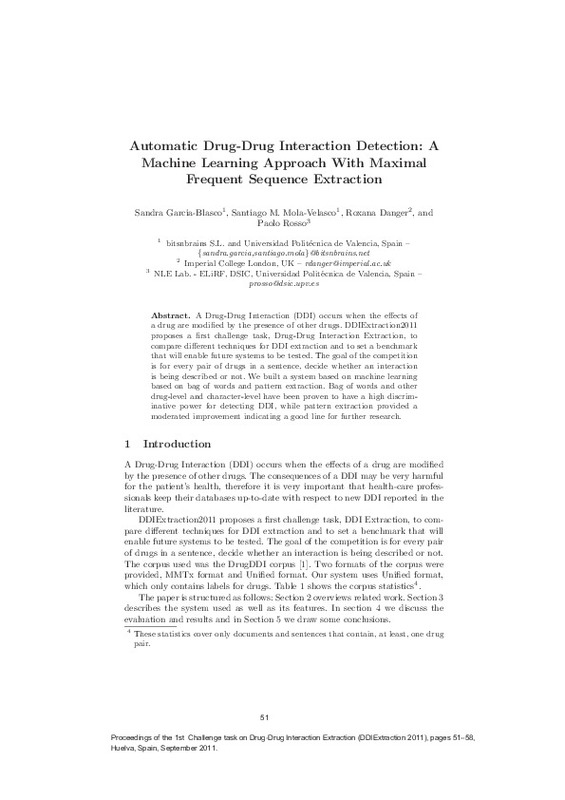JavaScript is disabled for your browser. Some features of this site may not work without it.
Buscar en RiuNet
Listar
Mi cuenta
Estadísticas
Ayuda RiuNet
Admin. UPV
Automatic Drug-Drug Interaction Detection: A Machine Learning Approach With Maximal Frequent Sequence Extraction
Mostrar el registro sencillo del ítem
Ficheros en el ítem
| dc.contributor.author | García Blasco, Sandra
|
es_ES |
| dc.contributor.author | Mola Velasco, Santiago Moisés
|
es_ES |
| dc.contributor.author | Danger Mercaderes, Roxana María
|
es_ES |
| dc.contributor.author | Rosso, Paolo
|
es_ES |
| dc.date.accessioned | 2013-11-12T13:29:41Z | |
| dc.date.issued | 2011 | |
| dc.identifier.issn | 1613-0073 | |
| dc.identifier.uri | http://hdl.handle.net/10251/33478 | |
| dc.description.abstract | [EN] A Drug-Drug Interaction (DDI) occurs when the effects of a drug are modified by the presence of other drugs. DDIExtraction2011 proposes a first challenge task, Drug-Drug Interaction Extraction, to compare different techniques for DDI extraction and to set a benchmark that will enable future systems to be tested. The goal of the competition is for every pair of drugs in a sentence, decide whether an interaction is being described or not. We built a system based on machine learning based on bag of words and pattern extraction. Bag of words and other drug-level and character-level have been proven to have a high discriminative power for detecting DDI, while pattern extraction provided a moderated improvement indicating a good line for further research. | en_EN |
| dc.description.sponsorship | This work has been done in the framework of the VLC/CAMPUS Microcluster on Multimodal Interaction in Intelligent Systems. Contributions of first and second authors have been supported and partially funded by bitsnbrains S.L. Contribution of fourth author has been partially funded by the European Commission as part of the WIQEI IRSES project (grant no. 269180) within the FP 7 Marie Curie People Framework, by MICINN as part of the Text-Enterprise 2.0 project (TIN2009-13391-C04-03) within the Plan I+D+i. Computational resources for this research have been kindly provided by Daniel Kuehn from Data@UrService. | |
| dc.language | Inglés | es_ES |
| dc.publisher | CEUR Workshop Proceedings | es_ES |
| dc.relation.ispartof | CEUR Workshop Proceedings | es_ES |
| dc.rights | Reserva de todos los derechos | es_ES |
| dc.subject.classification | LENGUAJES Y SISTEMAS INFORMATICOS | es_ES |
| dc.title | Automatic Drug-Drug Interaction Detection: A Machine Learning Approach With Maximal Frequent Sequence Extraction | es_ES |
| dc.type | Artículo | es_ES |
| dc.embargo.lift | 10000-01-01 | |
| dc.embargo.terms | forever | es_ES |
| dc.relation.projectID | info:eu-repo/grantAgreement/MICINN//TIN2009-13391-C04-03/ES/Text-Enterprise 2.0: Tecnicas De Comprension De Textos Aplicadas A Las Necesidades De La Empresa 2.0/ | es_ES |
| dc.relation.projectID | info:eu-repo/grantAgreement/EC/FP7/269180/EU/Web Information Quality Evaluation Initiative/ | |
| dc.rights.accessRights | Abierto | es_ES |
| dc.contributor.affiliation | Universitat Politècnica de València. Departamento de Sistemas Informáticos y Computación - Departament de Sistemes Informàtics i Computació | es_ES |
| dc.description.bibliographicCitation | García Blasco, S.; Mola Velasco, SM.; Danger Mercaderes, RM.; Rosso, P. (2011). Automatic Drug-Drug Interaction Detection: A Machine Learning Approach With Maximal Frequent Sequence Extraction. CEUR Workshop Proceedings. 761:51-58. http://hdl.handle.net/10251/33478 | es_ES |
| dc.description.accrualMethod | S | es_ES |
| dc.relation.conferencename | Workshop on Drug-Drug Interaction Extraction (DDIExtraction2011) | es_ES |
| dc.relation.conferencedate | September 09, 2011 | es_ES |
| dc.relation.conferenceplace | Huelva, España | es_ES |
| dc.relation.publisherversion | http://ceur-ws.org/Vol-761/ | es_ES |
| dc.description.upvformatpinicio | 51 | es_ES |
| dc.description.upvformatpfin | 58 | es_ES |
| dc.type.version | info:eu-repo/semantics/publishedVersion | es_ES |
| dc.description.volume | 761 | es_ES |
| dc.relation.senia | 217499 | |
| dc.contributor.funder | European Commission | |
| dc.contributor.funder | Ministerio de Ciencia e Innovación |






